Lara Weiss and her team write a digging diary every week (see below photos)
Excavations in Saqqara 2019
15 March 2019 a research team from the National Museum of Antiquities arrived in Egypt, near the village of Saqqara. That is the excavation site where they do six weeks of research every year into an ancient Egyptian burial ground. This year the team is going to dig a piece of land under which perhaps a grave is located. Just like last year, the Milanese 3D Survey Group will perform a number of underground scans. A stone conservator and a specialist for research of human remains were also brought along. Together with the project partners of the Turin Museo Egizio, we hope for beautiful and interesting finds this year.
Partner Museo Egizio
The team consists of several scientists and is led by Dr. Lara Weiss, curator of the Egyptian collection of the National Museum of Antiquities and Dr. Christian Greco, director of the Museo Egizio, Turin. The project is co-funded by the Netherlands Organisation for Scientific Research.
- Read more about the backgound and history of the excavation project in Saqqara.
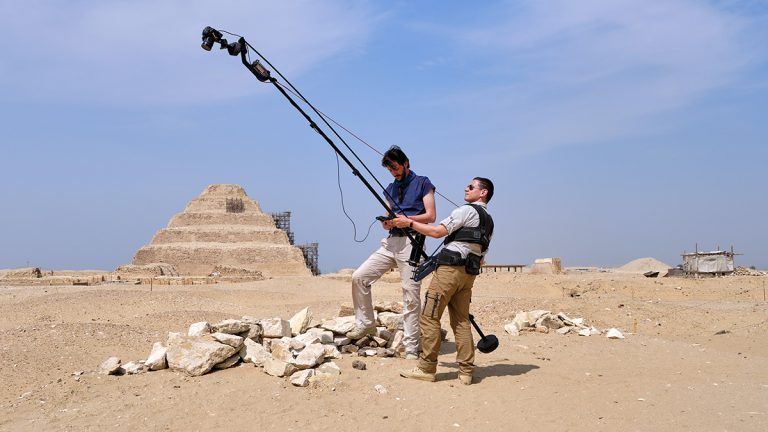
Week 3: Alessandro and Luca surveying the excavation area.
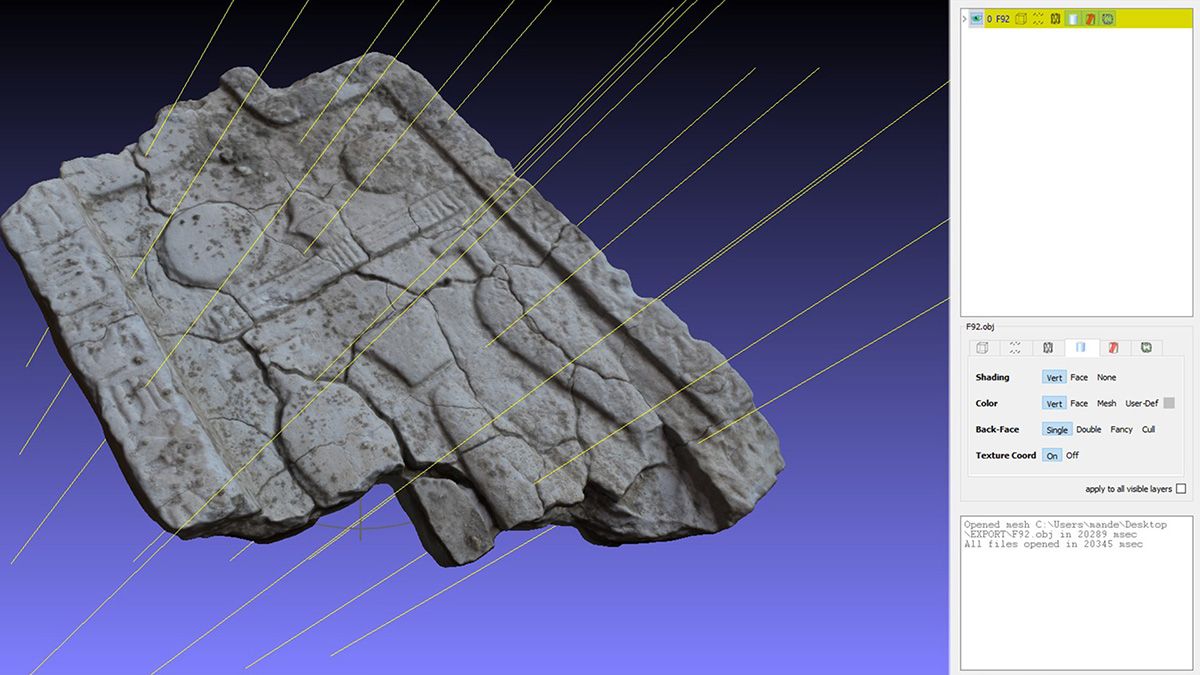
Week 3: 3D model of Find number 92 with artificial light. Elaboration: Luca Perfetti and Alessandro Mandelli.
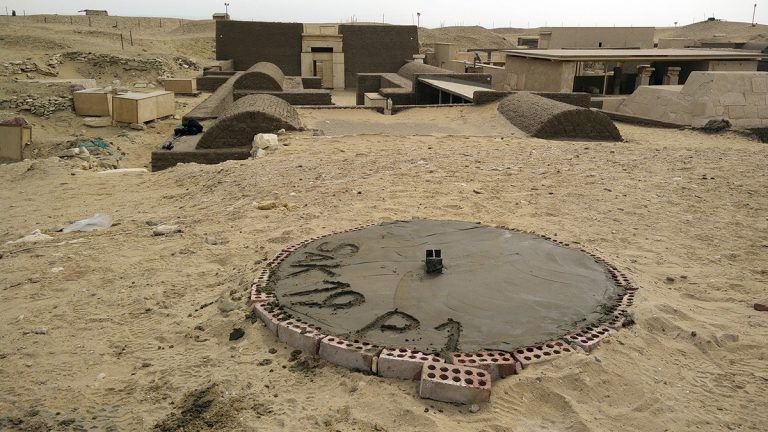
Week 3: new topographic point SAK19P1 in front of Maya’s Tomb.
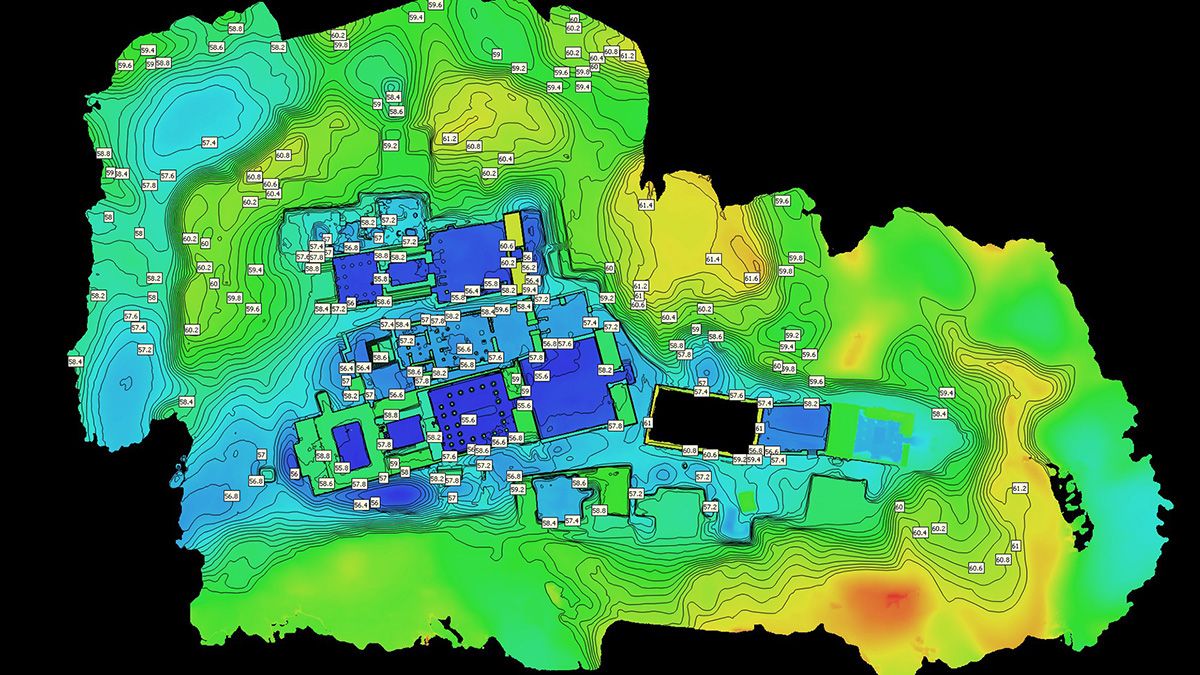
Week 3: DSM (Digital Surface Model). Elaboration: Luca Perfetti.
Digging diary
Week 3 (29 March – 5 April 2019)
Diary
Recording in 3D:
The 3DSurveyGroup of the ABC Department, Politecnico di Milano joined for the second year the Leiden-Turin excavation. The research group, headed by Professor Francesco Fassi and Professor Cristiana Achille, is active in the field of 3D survey, modelling and valorisation of Cultural Heritage (see photograph 1, week 3). The main activities are: architectural and archaeological survey, monitoring, high resolution and detailed 3D models management, teaching and training.
This season, the team consists of Alessandro Mandelli and Luca Perfetti, with the external collaboration of Professor Corinna Rossi. They are in charge of recording in 3D the entire excavation process, ranging from the whole area of the concession, to the contexts and the small finds that come up during the digging activities.
Within the dualism technology-human sciences, the role of the 3DSurveyGroup is to put metrology at service of the experts in the team, of the public, as well as of future memory. The group’s mission is to join forces with all the team members to maximize data recording before the progress of the excavation destroys the archaeological contexts. The aim is twofold: to increase the subsequent study potential when the mission ends, and to record and disseminate information on the actual context of the finds, that is usually lost.
The 3D models of the excavated area are useful tools to help the work of the archaeologists during and after the excavations. In fact, thanks to these products, they can track the history and the progress of the work and they are able to “travel” back in time, revisiting forever lost contexts from the very first to the last day of the season.
Using such a tool, the archaeologists, back in their offices in Leiden and Turin, can surf the raw, unbiased data from the excavation days, searching for missing information they lost track of, or seeking the answer to unforeseen questions.
When the digging team find something interesting, such as reliefs, pottery and burials the survey team immediately records the situation by acquiring photos and measuring the coordinates of the findings. Later, they improve the first survey, according to the requests, and deliver to each expert what they need.
The Politecnico team provided high-resolution orthophotos that were used to outline some inscriptions engraved in the stone. If the orthophoto is not clear enough, using a normal laptop archaeologists are able to simulate lights moving around the object and illuminate it in various ways, to better understand the signs and drawings. This represents a successful example of collaboration between technical and humanistic sides, in which the former identifies the most efficient tool to answer the questions posed by the latter.
All the digital models are collected together in a sort of three-dimensional database, each one in their relative position (see photograph 2, week 3). This is possible thanks to the topographic network around the excavation area that was checked by the survey team during the very first days of the mission. During the second week, due to the expansion of the excavation area, they placed and precisely measured a new topographic point in front of Maya’s Tomb (see photograph 3, week 3), and the workers removed the old one.
This year, the team is going to face many challenges: 1) generate the DSM (Digital Surface Model) of the whole concession (see photograph 4, week 3); 2) complete the 3D models of the main tombs; 3) survey the Meryneith underground chambers.
After a long walk in the concession using fish-eye lenses to create more than 1.500 photos, the digital model of the concession is nearly concluded. This kind of representation, with the contour lines, helps to understand the topology of the area and the landscape around the main tombs.
Last year, the team performed a complete survey of the tombs of Maya and Tia and then delivered accurate digital models of the tombs and their reliefs, kindly sponsored by the Friends of Saqqara Foundation. This year the aim is to collect all the data to reproduce also the tombs of Horemheb, Pay, Ptahemwia and Meryneith. Right in these days, the surveys are quite finished and the elaboration is going on.
Regarding the survey of Meryneith’s shaft and its underground chambers, our Ph.D. student Luca is eager to test a time-effective and low-cost photogrammetric device to survey narrow spaces together with elaboration methodology to guarantee accuracy. The aim is to tailor this technique to cope with the many challenges of surveying this kind of spaces like the tightness of the environment, the absence of any sort of natural illumination and the mazy, meandering architecture. Last year, the team faced a similar situation, when they surveyed a shaft in front of one of the Ramesside chapels in the north area.
In the next days, when the shaft will be opened, they are going to construct a test to compare different approaches and techniques and check for final accuracy. … but if you want to know more… stay tuned with the Leiden-Turin Expedition to Saqqara!
Week 2 (22-29 March 2019)
Diary
by Stefanie Papenheim:
My name is Stefanie and I arrived in Cairo on the 21st of March to join the Leiden-Turin team, supporting them to preserve the archeological stone finds of this season.
I studied conservation and restoration at the University of Applied Science Erfurt (Germany) and I‘m specialized in the treatment of stone and wall-paintings. Since 2014, I work at a private restauration company in Weimar with a focus on the conservation and restoration of stone sculptures and historic gypsum busts from museum collections. I am very happy to be here, as it is in fact not the first time that I had the chance to work on amazing Egyptian artefacts from Saqqara. In 2015, I supported the Leiden Museum to preserve and restore some of their most famous exhibits, for example the limestone tomb statues of Maya and Meryt.
During the first two days on the excavation site I got a first overview of the latest findings, the material and the condition of preservation. Most of the object in the storage are impressive reliefs made from limestone with fragments of polychrome colour. They show damage typical for limestone such as flaking, powdering, cracking or exogenous and endogenous deposition like firmly adhering crusts from mud, sand and salts. In general these kinds of damage are caused by salinization combined with high changes in temperature and relative air humidity or water infiltration.
This means that the main conservation work focuses on the reduction of deposition and structurally damaging salts, and on the stabilization of the limestone by consolidating it. All surfaces have to be cleaned carefully with soft brushes and if necessary with a mixture of water and alcohol. During all interventions it is important to reduce the water input to a minimum to avoid the solution and transportation of salts. In some cases a salt reduction with a desalination compress is necessary. Scalings and cracks have to be glued and backfilled. Surface completions of scalings and cracks have to be applied to stabilize the fine and skillfully carved relief. The fragile and flaking fragments of colour on the polished relief surfaces of course require a lot of patience and a very sensitive treatment to fix them.
In my work, I am supported by Islam Taha, conservator in the Ministry of Antiquities and student of Architecture Preservation and Rehabilitation of Heritage Buildings at Cairo University. We enjoy the team work and it‘s very nice to exchange our experiences. We are very much looking forward to working together on various sculptures and reliefs on the excavation site and in the magazines in the upcoming two weeks. We are happy to help preserving them for the future!
Week 1 (17-22 March 2019)
Diary
by Lara Weiss:
It’s on! This year’s excavation campaign (17 March to 24 April) started far more comfortable than we are used to. Because of the frequent travels to Egypt in the scope of our new EU project with the Egyptian Museum in Cairo, we were able to negotiate a nice deal with a hotel in Zamalek that we are also allowed to use for our travel to the excavation. This is nice, because we have now a big team where we can all be together. On Friday 15 March, the whole team could therefore share a delicious breakfast buffet with Nile view! After some shopping we were ready to go to Saqqara. Our Saqqara driver Hassan Yusef came to pick us up in his Peugeot and Moshir Tawfik, the driver of NVIC, came as well with two cars to get the total of 13 team members and all our equipment to the dig house.
Atef Sayed Ramadan, our cook, had already arranged for our equipment such as books and mosquito nets to be moved to the house from the Saqqara storage. So we could unpack immediately upon our arrival. The next day, Saturday 16 March, the team went on a field trip to the Imhotep site museum, the Serapeum, the Djoser complex, and the tombs of Maia and Nemtymes in the Bubasteion area.
On Sunday 17 March, we opened the site and started working. Important to know for our friends and colleagues is a new regulation by the Supreme Council of Antiquities (SCA), that limits our opportunity to receive visitors, as they now have to be approved by an official letter by the Head of the SCA, Mostafa Waziri. We are therefore obliged to kindly ask you not to visit our excavation area this season to avoid difficulties.
The plans for this season’s work are exciting. We will continue to work in the area north of the tomb of Maya and explore and excavate the entrance to the new large tomb we found in 2018. In addition, PhD student Luca Perfetti, a member of the 3D Survey Group, will survey the underground chambers of the Early Dynastic tomb that is situated underneath of the tomb of Meryneith. These subterranean rooms were already discovered at the time of excavation of the tomb of Meryneith (c. 1325 v.Chr.), but with the new methodology we hope to get even better analysis results of the space to be published soon by Ilona Regulski. In addition, the 3D Survey Group started a new survey of the tomb of Horemheb.
Work is also continuing on material from previous seasons, including small finds, pottery and skeletal material. Osteologist Ali Jelene Scheers studies the child burials we found last year, and Pottery specialists Valentina Gasperini and Alice Salvador keep up with the pottery found in 2018 and continue with the creation of their new typology. Last but not least, Barbara Aston and Lyla Pinch Brock will hopefully finalize the pottery for Maarten Raven’s publication of the area of the so-called Five Tombs.
In this first week we continued to remove the debris of earlier excavations in the area north of Maya in order to remove the sands and be able to excavate further the tomb that was discovered last season. Beside several small shabti figurines and secondary deposits of burial materials, several objects were found among which a piece of Greek or Coptic papyrus and a small inscribed offering table.
Now we will relax a little bit and catch up sleep, and very much look forward to continue digging on Saturday!
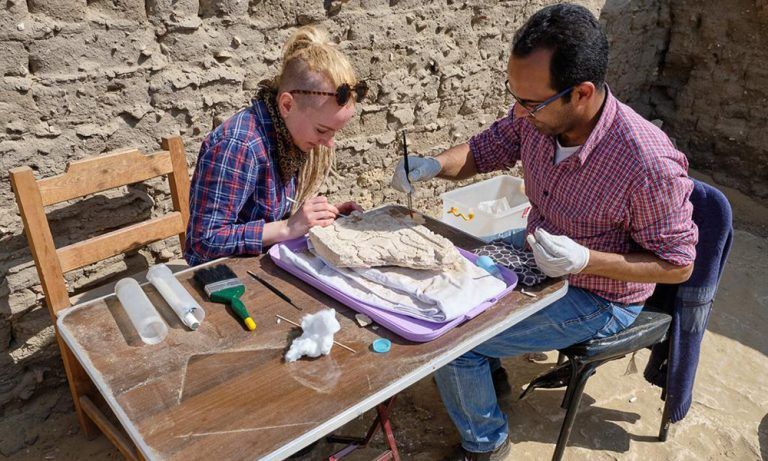
Week 2: Stefanie and Islam working on the offering table found last week.
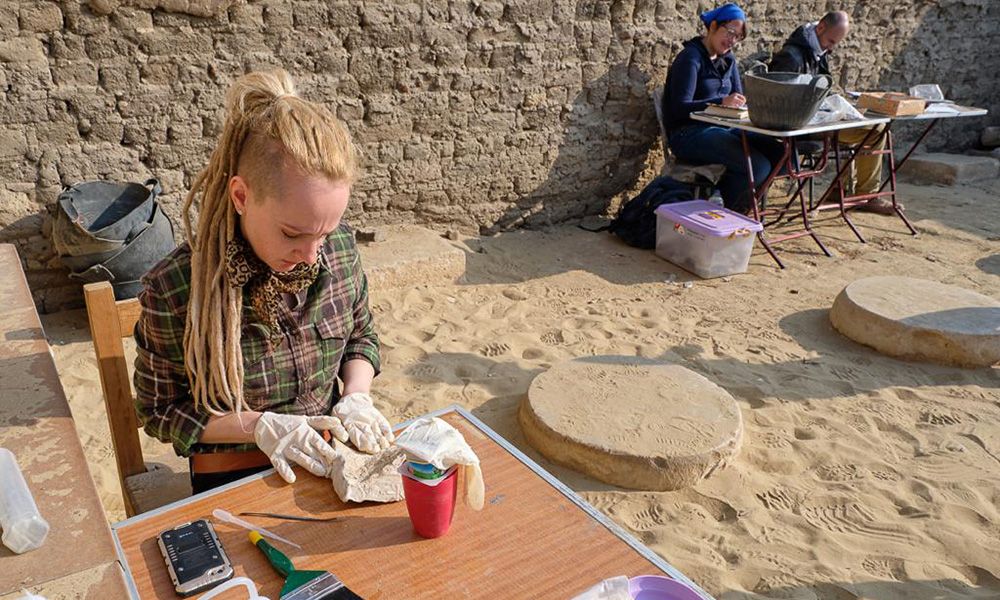
Week 2: our office in the tomb of Maya.
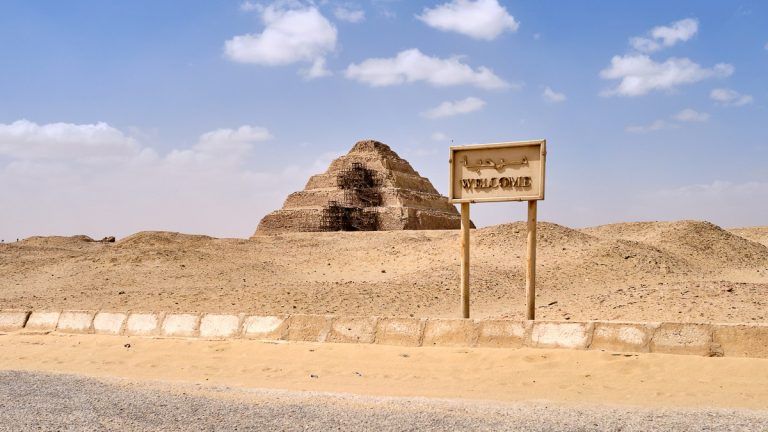
Week 1: welcome to Saqqara!
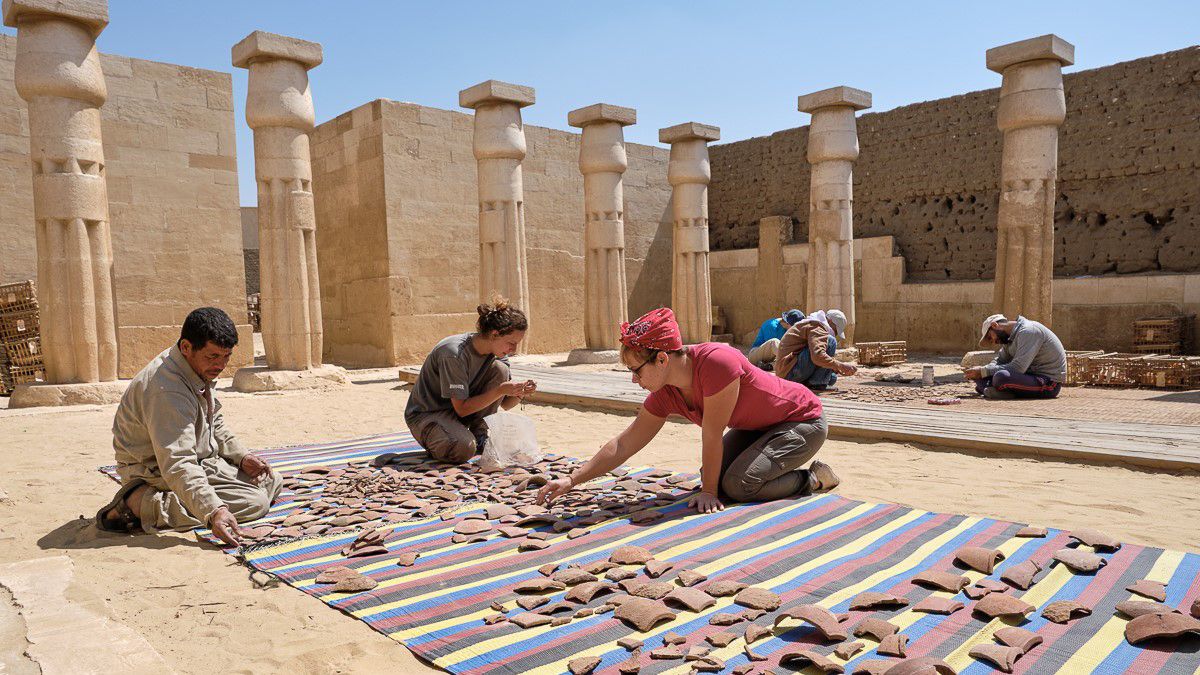
Week 1: Valentina Gasparini and Alice Salvador are working with local staff in the tomb of Horemheb.